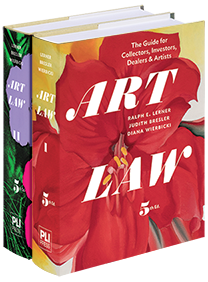Art Law is the brainchild of the ultimate art law duo, Ralph E. Lerner and his late wife, Judith Bresler. Originally drafted over 30 years ago, it’s the go-to legal resource for attorneys, art world professionals and collectors. Now in its fifth edition, and co-authored by Diana Wierbicki, the treatise needs to be on the bookshelf of any professional who works with artists, dealers or collectors.
The strength of the treatise lies in its plain English narrative, which distills complex legal issues faced in our field into straightforward text that’s easily understood by those who don’t regularly practice art law and by those who have no legal training, coupled with extensive footnotes for professionals wishing to further investigate any issue. The treatise is broad in scope (two volumes with 18 chapters covering artist-dealer relationships, private sales, art theft and breach of warranty claims, auctions, prints and sculpture multiples, commissioned works, expert opinions and liabilities, international trade, Holocaust-looted art, First Amendment rights, copyright, moral rights, resale rights, income tax and sales and use tax considerations, estate planning for collectors, business, tax, and estate planning for artists, museums and art and technology). Often, over the years, faced with a narrow legal issue relating to art, I’ve perused the treatise to see whether the authors have ever thought of the issue at hand, and more often than not, I see commentary addressing that narrow, sometimes untested, issue of law.
Estate-Planning Issues
Wealth advisors and trusts and estates attorneys undoubtedly will rely most on the comprehensive review and analysis of estate-planning issues (including forms) for both artists and collectors, including text discussing the Tax Cuts and Jobs Act of 2017. Valuation issues are paramount for estates containing works of art, and issues of blockage and other discounts are discussed in addition to how to proceed with the Internal Revenue Service Art Panel. Tax considerations in making charitable donations — who’s a “qualified appraiser” and what’s a “qualified appraisal” are explained in detail. The treatise discusses the use of works of art with charitable remainder trusts, charitable lead trusts, private foundations and IRS advance rulings for art valuations. In addition, the treatise covers sales and use tax concerns for art transactions, taking into consideration the recent Supreme Court decision in South Dakota v. Wayfair.
Art Law generously supplies numerous form agreements that practitioners can use in their practice. Dabblers will delight in adapting the sample private sale agreements, art commission agreements, and consignment agreements and in reviewing the standard auction agreements from Christie’s, Sotheby’s and Phillips.
Even though the art world and its accompanying group of legal advisors has expanded greatly since the first publication, no one has bested this treatise. As long as the authors periodically update the treatise in the coming years, it’s unlikely that anyone will.
 Art Law: The Guide for Collectors, Investors, Dealers & Artists (fifth edition)
Art Law: The Guide for Collectors, Investors, Dealers & Artists (fifth edition)
By Ralph E. Lerner, Judith Bresler, Diana Wierbicki
Available on Amazon, $399
Amelia K. Brankov is counsel at Frankfurt Kurnit Klein & Selz P.C., and the chair of Trusts & Estates magazine’s Art, Antiques & Auctions editorial advisory committee.

